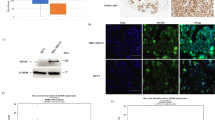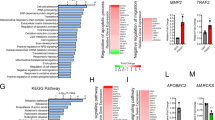Abstract
AKT2 is a serine/threonine kinase implicated in human ovarian and pancreatic cancers. AKT2 is activated by a variety of growth factors and insulin via phosphatidylinositol 3-kinase (PI3K). However, its normal cellular role is not well understood. To gain insight into the function of AKT2, we performed yeast two-hybrid system to screen for interacting proteins. Using this technique, we identified a novel interactor, designated APPL, which contains a pleckstrin homology (PH) domain, a phosphotyrosine binding (PTB) domain and a leucine zipper, classes of motifs defined in signaling molecules as functional interaction domains with specific targets. The PH domain of APPL shows similarity to those found in GTPase-activating proteins such as oligophrenin-1 and Graf, whereas its PTB domain exhibits homology with CED-6, an adaptor protein that promotes engulfment of apoptotic cells, and IB1, a transactivator of the GLUT2 gene. APPL is highly expressed in skeletal muscle, heart, ovary and pancreas, tissues in which AKT2 mRNA is abundant. APPL interacts with the inactive form of AKT2; moreover, APPL binds to the PI3K catalytic subunit, p110α. These data suggest that APPL is an adaptor that may tether inactive AKT2 to p110α in the cytoplasm and thereby may expedite recruitment of AKT2 and p110α to the cell membrane upon mitogenic stimulation. Furthermore, the APPL gene was mapped to human chromosome 3p14.3-p21.1, where deletions and other rearrangements have often been reported in a variety of tumor types. The identification of APPL may facilitate further analysis of the physiological and oncogenic activities of AKT2.
This is a preview of subscription content, access via your institution
Access options
Subscribe to this journal
Receive 50 print issues and online access
$259.00 per year
only $5.18 per issue
Buy this article
- Purchase on Springer Link
- Instant access to full article PDF
Prices may be subject to local taxes which are calculated during checkout







Similar content being viewed by others
References
Altomare DA, Guo K, Cheng JQ, Sonoda G, Walsh K and Testa JR. . 1995 Oncogene 11: 1055–1060.
Altomare DA, Lyons GE, Mitsuuchi Y, Cheng JQ and Testa JR. . 1998 Oncogene 16: 2407–2411.
Bell DW, Taguchi T, Jenkins NA, Gilbert DJ, Copeland NG, Gilks CB, Zweidler-McKay P, Grimes HL, Tsichlis PN and Testa JR. . 1995 Cytogenet. Cell Genet. 70: 263–267.
Billuart P, Bienvenu T, Ronce N, des Portes V, Vinet MC, Zemni R, Crollius HR, Carrie A, Fauchereau F, Cherry M, Briault S, Hamel B, Fryns JP, Beldjord C, Kahn A, Moraine C and Chelly J. . 1998 Nature 392: 923–926.
Blume-Jensen P, Janknecht R and Hunter T. . 1998 Curr. Biol. 8: 779–782.
Bonny C, Nicod P and Waeber G. . 1998 J. Biol. Chem. 273: 1843–1846.
Bullard B, Leonard K, Larkins A, Butcher G, Karlik C and Fryberg E. . 1998 J. Mol. Biol. 204: 621–637.
Calera MR, Martinez C, Liu H, Jack AK, Birnbaum MJ and Pilch PF. . 1998 J. Biol. Chem. 273: 7201–7204.
Carpenter CL and Cantley LC. . (1996) Curr. Opin. Cell Biol. 8: 153–158.
Cheng JQ, Altomare DA, Klein MA, Lee WC, Kruh GD, Lissy NA and Testa JR. . 1997 Oncogene 14: 2793–2801.
Cheng JQ, Godwin AK, Bellacosa A, Taguchi T, Franke TF, Hamilton TC, Tsichlis PN and Testa JR. . 1992 Proc. Natl. Acad. Sci. USA 89: 9267–9271.
Cohen GB, Ren R and Baltimore D. . 1995 Cell 80: 237–248.
Cong LN, Chen H, Li Y, Zhou L, McGibbon MA, Taylor SI and Quon MJ. . 1997 Mol. Endocrinol. 11: 1881–1890.
Cross DA, Alessi DR, Cohen P, Andjelkovich M and Hemmings BA. . 1995 Nature 378: 785–789.
Datta SR, Dudek H, Tao X, Masters S, Fu H, Gotoh Y and Greenberg ME. . 1997 Cell 91: 231–241.
del Peso L, Gonzalez-Garcia M, Page C, Herrera R and Nunez G. . 1997 Science 278: 687–689.
Delcommenne M, Tan C, Gray V, Rue L, Woodgett J and Dedhart S. . 1998 Proc. Natl. Acad. Sci. USA 95: 4374–4379.
Franke TF, Kaplan DR, Cantley LC and Toker A. . 1997 Science 275: 665–668.
Golemis EA, Gyuris J and Brent R. . (1994). Ausubel FM, Brent R, Kington RE, Moore DD, Seidman JG, Smith JA and Struhl K. (eds). Current Protocols in Molecular Biology. John Wiley and Sons: New York pp. 13.14.1–13.14.17.
Harlan JE, Hajduk PJ, Yoon HS and Fesik SW. . 1994 Nature 371: 168–170.
Hildebrand JD, Taylor JM and Parsons JT. . 1996 Mol. Cell. Biol. 16: 3169–3178.
Jones PF, Jakubowicz T and Hemmings BA. . 1991 Cell Regul. 2: 1001–1009.
Kavanaugh WM, Turck CW and Williams LT. . 1995 Science 268: 1177–1179.
Kok K, Naylor SL and Buys CHCM. . 1997 Adv. Cancer Res. 71: 27–92.
Kozak M. . 1987 Nucleic Acids Res. 15: 8125–8148.
Lankes WT, Schwartz-Albiez R and Furthmayr H. . 1993 Biochim. Biophys. Acta 1216: 479–482.
Liu AX, Testa JR, Hamilton TC, Jove R, Nicosia SV and Cheng JQ. . 1998 Cancer Res. 58: 2973–2977.
Liu QA and Hengartner MO. . 1998 Cell 93: 961–972.
Mitsuuchi Y, Johnson SW, Moonblatt S and Testa JR. . 1998 J. Cell. Biochem. 70: 433–441.
Pawson T. . 1995 Nature 373: 573–580.
Rameh LE, Chen CS and Cantley LC. . 1995 Cell 83: 821–830.
Ruggeri BA, Huang L, Wood M, Cheng JQ and Testa JR. . 1998 Mol. Carc. 21: 81–86.
Staal SP. . 1987 Proc. Natl. Acad. Sci. USA 84: 5034–5037.
Thrower DA, Jordan MA, Schaar BT, Yen TJ and Wilson L. . 1995 EMBO J. 14: 918–926.
Walker KS, Deak M, Paterson A, Hudson K, Cohen P and Alessi DR. . 1998 Biochem. J. 331: 299–308.
Yen TJ, Li G, Schaar BT, Szilak I and Cleveland DW. . 1992 Nature 359: 536–539.
Zhou MM, Ravichandran KS, Olejniczak EF, Petros AM, Meadows RP, Sattler M, Harlan JE, Wade WS, Burakoff SJ and Fesik SW. . 1995 Nature 378: 584–592.
Acknowledgements
We thank Dr B Balsara, Dr A De Rienzo, S Moonblatt, Dr S Tanno and A Tosolini for technical assistance, and Drs A Bellacosa, J Chernoff, G Kruh, Y Matsumoto and RP Perry for critical review of the manuscript. This work was supported by American Cancer Society grant #RPG-92-006-05-EDT, NCI Grants CA-77429 and CA-06927, and by an appropriation from the Commonwealth of Pennsylvania.
Author information
Authors and Affiliations
Rights and permissions
About this article
Cite this article
Mitsuuchi, Y., Johnson, S., Sonoda, G. et al. Identification of a chromosome 3p14.3-21.1 gene, APPL, encoding an adaptor molecule that interacts with the oncoprotein-serine/threonine kinase AKT2. Oncogene 18, 4891–4898 (1999). https://doi.org/10.1038/sj.onc.1203080
Received:
Revised:
Accepted:
Published:
Issue Date:
DOI: https://doi.org/10.1038/sj.onc.1203080
Keywords
This article is cited by
-
Retrograde transport of Akt by a neuronal Rab5-APPL1 endosome
Scientific Reports (2019)
-
Metabolic Messengers: adiponectin
Nature Metabolism (2019)
-
Recent advances of adapter proteins in the regulation of heart diseases
Heart Failure Reviews (2017)
-
Experimental verification of a predicted novel microRNA located in human PIK3CA gene with a potential oncogenic function in colorectal cancer
Tumor Biology (2016)
-
Adaptor protein APPL1 interacts with EGFR to orchestrate EGF-stimulated signaling
Science Bulletin (2016)



